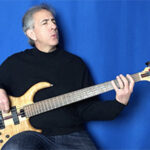I bet you never thought about playing bass like this
By Jon Liebman
March 17, 2023
“I just made kind of an off-handed comment as a joke, and then later, he came to me and was really struck by it.”
Those words, spoken to me by Jared MacEachern, longtime bassist with Machine Head, led to a truly thoughtful approach for bass players in the quest for locking in with both the guitar player and the drummer.
His observation makes so much sense…
The bass player’s job
The bass player has a dual responsibility. On the one hand, we have to function as the timekeeper, laying down the groove and making sure everyone feels the pulse.
At the same time, we also have to outline the harmony. That’s one reason we start by playing the root of the chord on the downbeat, every time a new chord is introduced. What we do between those roots is also a big part of the art form.
“You’re the bridge between the rhythm and the melody,” Jared says, recalling the conversation he had with a friend. “He’s a guitar player,” Jared explains, “but he was having to fill in on bass for another friend of ours. He knows that it’s a different animal.”
A distinctly different role for each hand
Seeing that his friend was a little nervous about playing bass, Jared did his best to calm him down. “Easy,” he said, reassuringly. Just remember this: “Right hand, drum stuff; left hand, guitar stuff.”
Interesting. But what exactly does that mean?
“Many times that will be matching what the drums are doing because you’re that rhythmic bridge,” explains Jared. “And then you use the notes to help establish what the guitar is doing.”
What you do with your right hand – or whichever hand is you’re plucking hand – is often perfectly in sync with the kick drum (hence, “right hand, drum stuff”).
Your fretting hand, in turn, controls notes, pitch, harmony, etc. (i.e., “left hand, guitar stuff”).
One more time…
“So, the rhythm with the drums, and then the melody and the notes with the guitar,” he repeats.
What a revelation
“It just kind of hit me,” Jared says, recalling when he first made that discovery, “and I was so much more locked in with the drummer.”
If you’ve ever heard the reference to the bass being the bridge between rhythm and harmony, now you have a new way of looking at it.
“Before I’d been playing bass,” says Jared, “I was like part of the lead thing. I was writing songs like a guitar (player), so I was playing like that.”
This new way of looking at it was a real eye-opener.
“But then I was, ‘Oh, I can just lay back. Now I can fill that spot where the bass goes, between the rhythm and the melody,’” he says. “I’ve just really settled into that and it’s a great place to be.”
How about you?
Do you have any tricks for locking in the time with the drummer and/or staying simpatico with the guitar and keyboard? Leave a comment below and tell me what you do.
Inside the Bottom Line Club, my membership program for learning bass, students are fully immersed in learning how groove in a way that’s fun and makes the music feel good, finessing that balancing act between rhythm and harmony.
For more info and to join the Bottom Line Club, click here.
Let’s play bass!
Jon






I don’t have experience of playing bass in a band, but I’ll mention some things I’ve been taught and maybe you could tell me if I’m thinking along the right lines. First of all the bass is part of the rhythm section and so the bass player needs to lock in with the drums (even if the bass is playing a syncopated rhythm it’s the drums that set the timing). Secondly, the bass needs to mark the chord changes by playing the roots – the guitar player shouldn’t have to do this and they have an equal responsibility not to interfere with what the bass is doing. If the guitar is a rhythm guitar then I would say they need to lock in with the bass and be the bridge by comping for the lead guitar, then the lead guitar is free to go off shredding the fancy licks in the higher register. Personally, when I’m practising bass with backing tracks, I sometimes have to ignore the guitar and focus on the drums because the guitarist can sometimes get carried away and put me out of my groove! The bassist also has to be aware of harmony by playing notes which are supportive of the guitar, which don’t clash and mess up the overall sound of the music, but which add to it – at the end of the day all the different musicians need to be listening to each other and seeking to work together to make the music sound good. One thing I’ve observed about the bass, which isn’t often mentioned, is that it’s a very powerful instrument and, in the hands of a good player, it’s able to drive the momentum and direction of the music – push it forward so it’s moving and not just ambling in one place or going nowhere – I think that’s to do with phrasing and dynamics, is it?
Celia, yes, you’re on the right track. I was a little concerned at first when you mentioned having to “ignore” the guitar, so I was glad you said that “all the different musicians need to be listening to each other and seeking to work together to make the music sound good.” The bass functions as both the timekeeper (along with the drummer) and supplier of harmony (along with the guitar and/or piano). It’s a wonderful responsibility!
As for driving the momentum and direction of the music, it’s not only phrasing and dynamics; it’s also playing with conviction and setting the foundation for the rest of the band.
I hope that helps. I love your never-ending quest to continue improving as a bass player. Very inspiring. Thanks for weighing in!